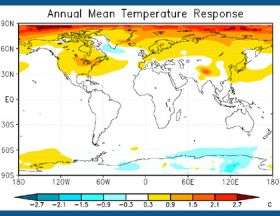Dirty snow may warm Arctic as much as greenhouse gases

The global warming debate has focused on carbon dioxide emissions, but scientists at UC Irvine have determined that a lesser-known mechanism -- dirty snow -- can explain one-third or more of the Arctic warming primarily attributed to greenhouse gases.
Snow becomes dirty when soot from tailpipes, smoke stacks and forest fires enters the atmosphere and falls to the ground. Soot-infused snow is darker than natural snow. Dark surfaces absorb sunlight and cause warming, while bright surfaces reflect heat back into space and cause cooling.
“When we inject dirty particles into the atmosphere and they fall onto snow, the net effect is we warm the polar latitudes,” said Charlie Zender, associate professor of Earth system science at UCI and co-author of the study. “Dark soot can heat up quickly. It’s like placing tiny toaster ovens into the snow pack.”
The study appears this week in the Journal of Geophysical Research.
Dirty snow has had a significant impact on climate warming since the Industrial Revolution. In the past 200 years, the Earth has warmed about .8 degree Celsius. Zender, graduate student Mark Flanner, and their colleagues calculated that dirty snow caused the Earth’s temperature to rise .1 to .15 degree, or up to 19 percent of the total warming.
In the past two centuries, the Arctic has warmed about 1.6 degrees. Dirty snow caused .5 to 1.5 degrees of warming, or up to 94 percent of the observed change, the scientists determined.
The amount of warming by dirty snow varied from year to year, with higher temperatures in years with many forest fires. Greenhouse gases, which trap outgoing energy, are primarily responsible for the remaining temperature increase and are considered the Earth’s most important overall climate changing mechanism. Other human influences on Arctic climate change are particles in the atmosphere, including soot; clouds; and land use.
Humans create the majority of airborne soot through industry and fuel combustion, while forest and open-field fires account for the rest. Because of human activity, greenhouse gas levels have increased by one-third in the last two centuries.
“A one-third change in concentration is huge, yet the Earth has only warmed about .8 degrees because the effect is distributed globally,” Zender said. “A small amount of snow impurities in the Arctic have caused a significant temperature response there.”
Previous studies have analyzed dirty snow’s effect on climate, but this is the first to take into account realistic emissions from forest fires in the Northern Hemisphere and how warming affects the thickness of the snow pack.
In some polar areas, impurities in the snow have caused enough melting to expose underlying sea ice or soil that is significantly darker than the snow. The darker surfaces absorb sunlight more rapidly than snow, causing additional warming. This cycle causes temperatures in the polar regions to rise as much as 3 degrees Celsius during some seasons, the scientists say.
“Once the snow is gone, the soot that caused the snow to melt continues to have an effect because the ground surface is darker and retains more heat,” Zender said.
Dirty snow is prevalent in East Asia, Northern Europe and Northeastern United States.
Zender believes policymakers could use these research results to develop regulations to mitigate global warming. Limiting industrial soot emissions and switching to cleaner-burning fuels would leave snow brighter, he says. New snow falls each year, and if it contained fewer impurities, the ground would brighten and temperatures would cool. Carbon dioxide lives in the atmosphere for a century, so cutting back on emissions can prevent further warming but does not produce immediate cooling.
Source: University of California - Irvine




















